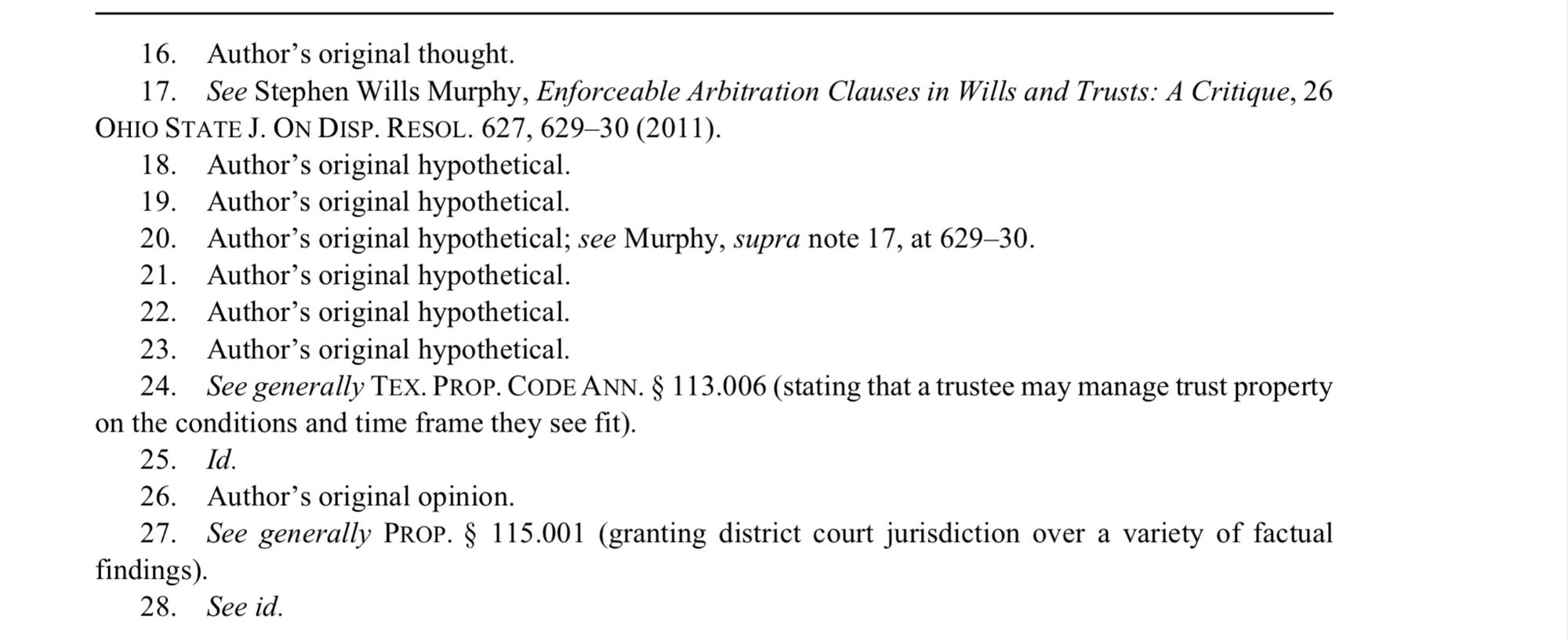Joyce W. Moore and Christian S. Kelso article1 in Estate Planning Journal focuses on thorny wills issues under Texas law,2 and tries to answer them.3 The article is especially useful to Texas lawyers, and it is also an excellent guide for questions that attorneys in other states need to try to answer according the laws of their jurisdictions.4
Notes on the Footnotes5
The article has 512 footnotes.6 Every sentence has a footnote,7 which is something I haven't seen before. Below are a few curious examples.8
There are footnotes explaining that the author is making thanking someone.9 For example:
The authors would like to thank their families for putting up with them while putting this Article together.(1)
(fn1) Author’s acknowledgments.
Several footnotes signal an original thought.10 For example:
Writing about trusts and estates cases can be difficult.(16)
(fn16) Author’s original thought.
At least one footnote explains that the statement is the author's original opinion:11
Other areas of the law lack the plethora of opportunities to distinguish rules based on factual minutiae.(26)
(fn26) Author’s original opinion.
Reading footnotes like this made me smile,12 and then it made me wonder:13 Since the article has two authors,14 which one had the original opinion and the original thought?15 Did both of them have it while talking together?16 Furthermore, whose idea was it to have a footnote for every sentence?17
Another question I had is why didn't the authors use "Id." more often -- for example, instead of repeating "Author's original hypothetical."?18

My blog post reminds me of the Saturday Night Live skit, More Cowbell; except, I could have used a little more footnotes:19
My blog post also reminds me of the children's book, 🔗More Bears!.20
- Unanswered Questions in Wills and Trusts (and How to Try and Answer Them (1/1/2022). ↩︎
- For example, section VI asks, "What Limits Can Be Placed on the Fiduciary Duties of Trust Protectors?" ↩︎
- Author's original (or maybe no so original) observation based on the title and contents of the article. ↩︎
- Despite the parody of the footnotes that this author's blog post makes, the author genuinely likes and recommends Moore and Kelso's well-researched and well-written article. ↩︎
- Author's original note. ↩︎
- See the last page (which is page 54) of the article. ↩︎
- Author looked quickly. But if you catch a sentence without a footnote, please leave a comment below. ↩︎
- Author's original experience as of February 17, 2022. Said author is quite impressed since he reads widely. ↩︎
- Author's original observation. ↩︎
- Also author's original observation. ↩︎
- Another author's original observation. Author is observant. ↩︎
- Author's original reaction. ↩︎
- Author's original experience. ↩︎
- Author's original observation. ↩︎
- Author's original question. ↩︎
- Another author's original question. ↩︎
- Author's original question. ↩︎
- Author's original question. ↩︎
- Author has a mere 20 footnotes in this article. Author has a fever, and the only prescription is more footnotes! ↩︎
- This is an Amazon affiliate link, which means the author may earn some commission at no extra cost to you if you make a purchase after clicking on the link. ↩︎
Hani Sarji
New York lawyer who cares about people, is fascinated by technology, and is writing his next book, Estate of Confusion: New York.





Leave a Comment